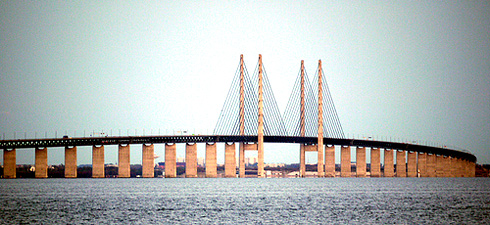On 1st July, the Øresund Bridge will celebrate its 10th anniversary. However, the atmosphere was far from festive when it was first opened a decade ago. The bridge-tunnel project had been through hell and water ever since it was approved by the Swedish and Danish parliaments back in 1991. Environmentalist opponents of the plan had organised protests on a massive scale.
Danes were much more ambivalent
The ambitions of southern Swedes who aimed to develop increased integration and to break down barriers between Sweden and Denmark had been systematically dismissed as ridiculous whims with no connection to the reality of the geographical and political landscape. The three-billion euro cost had provided the project's detractors with a further source of ammunition, and added to the general discontent, particularly in remote regions where infrastructure was chronically underfunded. Still others warned about a foreseeable increase in crime. The bridge would serve the needs of gangs in involved people, arms and drugs trafficking — a concern that latterly proved to be justified.
In spite of this widespread opposition, the residents of Scania and most of the other counties of southern Sweden had unshakable faith in the project and the enthusiasm and ironclad determination to push for its completion. On the other side of the sound, the Danes were much more ambivalent. Public interest in the project appeared to be uniquely focused on unflattering cliches of uptight Swedes whose lives are regulated by the opening hours of state alcohol shops and the tutorship of the Big Brother state.
20,400 cross-border workers
In the wake of the grand inauguration and an initial month during which the curious made the crossing in large numbers, traffic on the bridge fell far below forecasts and expectations. Then slowly but steadily it began to rise. The 11 universities and third level schools located in Øresund region established new cooperation and exchange agreements, and the flow of cars continued to grow. By 2009, the traffic had increased to 141% of the level recorded in the first full year of operation in 2001. Now an average of 72,000 people use the bridge every day — 41,300 by car and 30,400 by train. That is a total of 26 million people per year. And the increase in these statistics, which is a testament to the growing integration between the two countries, is set to continue.
Before the construction of the bridge, there were only 2,000 cross-border workers on either side of the sound. In 2009, that number had increased to 20,400. The overwhelming majority (95%) live in Sweden and work in Denmark. But 291 Danish companies have also opened up in Malmö where they employ close 5,400 people. Ida Hastrup, a 36-year-old Dane, moved to the Husie neighbourhood of Malmö with her husband and daughter four years ago. Every day she crosses the bridge to travel to Copenhagen Airport in Kastrup. "We are very happy in Sweden. People have a much greater respect for rules here, but the biggest difference is in the approach to children. In Sweden, children are the future. In Denmark, young people are a secondary concern."
Environmentalist opponents have changed tune
Over the last few years, even the environmentalist opponents of the bridge tunnel who insisted it would result in an ecological disaster — a reduction in the flow of water through the sound that would kill off fish and plant life — have been forced to change their tune. The reverse has proved to be the case. The bridge piles and the Lillgrund wind farm have formed an artificial reef that offers a sheltered environment for fish, kelp and mussels, while on dry land, the economy is flourishing. Trade, research, tourism, and even the labour and property have all been boosted by the bridge.
But can we now refer to residents of Copenhagen and Malmö as "citizens of Øresund?" Not according to Orvar Löfgren, a professor of ethnology at Lund University, "I'm not convinced by all this sales talk about total integration and the emergence of a new type of citizen. You have to value national identity and the individual traits and differences it implies. That is what makes it interesting to live in this region, and it is also what attracts us to explore the other side of the sound." For the Swedish academic, "what is important is the manner in which people take advantage of the wider range of choices in terms of jobs, accommodation, culture and entertainment that are made available by the bridge. More activity, cultural values, practical advantages and an increased sense of belonging: these have all contributed to an overall contribution to the quality of life, which varies from person to person."
From Denmark
A new mentality
To celebrate the 10th anniversary of the Øresund Bridge, the Danish and Swedish dailies Politiken and Sydsvenskan are publishing a joint supplement entitled Bron (which means bridge in Swedish). Politiken notes that in spite of expectations, the construction of the bridge did not result in an equal merger of two cities. Instead the city of Malmö “has come to function like a suburb of Copenhagen, to the point where some locals have renamed it 'København M’”.
However that said, there are many reasons to celebrate this 10th anniversary. The bridge has reinforced the regional economy. Copenhagen has been able to attract more highly qualified workers, and the link has enabled Sweden to resolve the problem of its citizens' disaffection for the suburbs. “The bridge over the sound is only a work of engineering, what is really important is the fact that has contributed to the broadening of horizons in both countries,” points out Politiken. The daily also notes that it has resulted in closer links between two peoples, to the point where young Danes have embraced "a life of exile" in Sweden to circumvent Danish immigration law, which refuses to recognize marriages between Danish citizens and foreigners if one of the partners is less than 24 years old.
Do you like our work?
Help multilingual European journalism to thrive, without ads or paywalls. Your one-off or regular support will keep our newsroom independent. Thank you!












